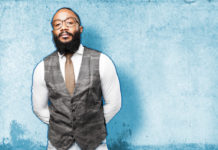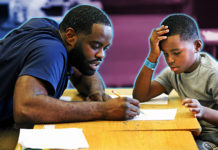Ayo Scott is a New Orleans painter who can teach us all something about the importance of connection, community and art as education. I first met Ayo at a community paint day at Xavier University. The room was crowded and bustling with art amateurs of all ages who had come to participate in a painting event sponsored by the Young Artist Movement, Arts Council New Orleans and Jean Lafitte National Historical Park & Preserve called the ART of Citizenship.
At one art station, we added color and sealant to a mural that Ayo had sketched out that depicted a social justice narrative of the immigrant experience. Not only was I impressed with the mural and the depth of the story it told, but also the artist’s bright smile and patience with everyone who wanted to help. He was clearly in his element—helping everyone around him, children and adults alike, find the joy of art.
Later, I met with him in his studio, a small rented space in a warehouse in Mid-City that he shares with other painters. I wanted to know more about him and his journey into community art projects. Almost immediately he told me both of his parents were educators. I wasn’t surprised, since I had already witnessed firsthand his talent for teaching, even in a crowded and chaotic space. He also humbly mentioned that his father, John Scott, was a renowned artist and that many of his opportunities were because a path had already been laid out before him.
Like many people, I can be quite clueless about art, so I didn’t grasp the import of his father’s name or impact on the art world until later at home when I researched him. I also thought to myself that Ayo was being a bit humble about his own talent. There is always a path laid out before us—whether it’s our parents or mentors, but we still have to do the work, and as Ayo expressed, we have “an obligation to pass on the legacy.”
“I’m always wanting to try and do better,” Ayo said.
That idea became even more important to him after his father passed. Inspired by his father’s legacy, he came together with three friends to start an open mic initiative called “Pass It On,” which was a way to celebrate poets, musicians, comedians, and other types of artists.
But Ayo didn’t always identify as an artist. Growing up he was immersed in the artistic world, but he didn’t necessarily recognize it as part of himself or his path. He attended high school at St. Augustine and Benjamin Franklin and was focused on a pre-med program. But he now realizes that what he experienced was in and of itself a teaching.
“Art is a form of education. I wasn’t pressured to be an artist. But I also grew up making paper out of blue jeans.”
He didn’t give much thought to art as a career until college. He started with a Biology Pre-Med major, but it didn’t feel quite right, and so he switched majors a few times before settling on art with a focus in graphic design. Later, when his father passed, he became more serious about art.
“There was suddenly a void of art in my life, and so it was a response to that void, to that loss…and to Katrina.”
His art has been inspired by a need to see beyond himself, whether that was a connection to his father, or his desire to serve others. He was in graduate school at the Institute of Design, located in Chicago, when he decided to take a year off to dedicate his art to the cause of the tsunami of 2004. He did a series of paintings inspired by the people affected. A year later, on the day he was to return to the Institute, Hurricane Katrina hit. As soon as the city officials allowed, he returned home to New Orleans.
Since then, he has been using his art as a way to build a connection in the community. He sometimes does substitute teaching to help “fill the void of Black men” who serve as role models to youth. He’s taught mural-making, ceramics, and graphic design. In viewing art as a form of education, he also believes in the importance of sharing it with youth, which is how he became involved with the Young Artist Movement. He has connections to the Arts Council, and he was a natural fit when they and their partner YAM were looking for a muralist to work with youth on the ART of Citizenship Mural Project.
In the changing landscape of New Orleans, Ayo feels a pressing need to preserve art in order to preserve the culture of the city, especially in schools.
“Artists are preservation warriors, cultural warriors. We are part of a tradition and in practicing that tradition we become cultural ambassadors…Our culture is being taken away from us. The whole process of rebuilding the city and schools has not been conducive to art. There is no respect for art in schools. It’s become a dumping ground for kids who need real help. It’s art on a cart and it can’t flourish in the school system we have right now.”
It is clear that through his art, Ayo imagines a world and an environment that nourishes creativity and is deeply connected, especially for our children. Part of what drew me to him was seeing him with his wife and daughter at the mural event. It was beautiful to see his expression of the love of the arts, family, and community all together in one place. He and his work is an inspiration for all of us to nourish our own creative spirits, to connect with one another, and to pass on the legacy.
You can view Ayo Scott’s work and get more information about the themes of his work on http://ayoscott.com.










